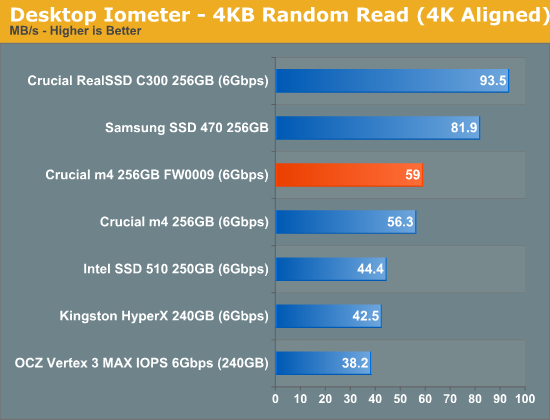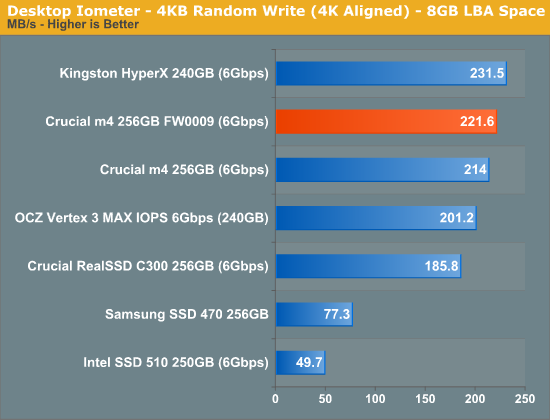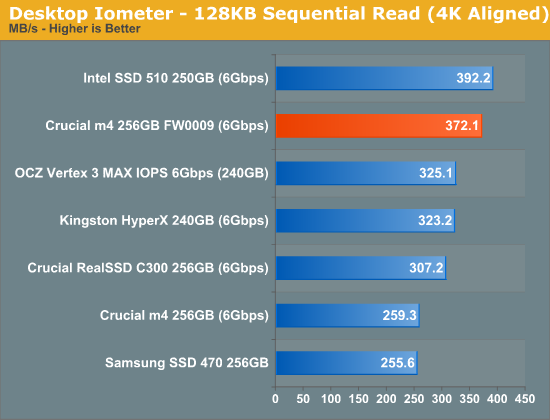The Crucial m4 SSD Update: Faster with FW0009
by Anand Lal Shimpi on August 31, 2011 12:56 AM ESTRandom Read/Write Speed
The four corners of SSD performance are as follows: random read, random write, sequential read and sequential write speed. Random accesses are generally small in size, while sequential accesses tend to be larger and thus we have the four Iometer tests we use in all of our reviews.
Our first test writes 4KB in a completely random pattern over an 8GB space of the drive to simulate the sort of random access that you'd see on an OS drive (even this is more stressful than a normal desktop user would see). I perform three concurrent IOs and run the test for 3 minutes. The results reported are in average MB/s over the entire time. We use both standard pseudo randomly generated data for each write as well as fully random data to show you both the maximum and minimum performance offered by SandForce based drives in these tests. The average performance of SF drives will likely be somewhere in between the two values for each drive you see in the graphs. For an understanding of why this matters, read our original SandForce article.

Random read performance was a strong suit of the old C300 and Crucial scaled back on it a bit when building the m4's firmware. The 0009 firmware improves performance a little bit but not tremendously. As we've seen in our previous reviews however, for desktop users being able to hit over 60MB/s in 4KB random reads doesn't translate into real world performance gains. All of the drives here do very well.

Random write performance also improved a little bit post update. The m4 is still incredibly fast here, easily the second fastest drive we've tested.
Many of you have asked for random write performance at higher queue depths. What I have below is our 4KB random write test performed at a queue depth of 32 instead of 3. While the vast majority of desktop usage models experience queue depths of 0 - 5, higher depths are possible in heavy I/O (and multi-user) workloads:

Crucial's performance doesn't scale up with higher queue depths like SandForce's. That's mostly because with highly compressible data sets, SF's drives don't actually write more as queue depth goes up. The controller has to do more deduping but as long as it can keep up, performance looks like it increases while physical writes to NAND don't. Most random writes on a desktop machine are going to be highly compressible, however most desktop workloads won't see sustained 4KB random writes at a queue depth of 32.
Sequential Read/Write Speed
To measure sequential performance I ran a 1 minute long 128KB sequential test over the entire span of the drive at a queue depth of 1. The results reported are in average MB/s over the entire test length.

Here's where we see some huge gains. The original m4 firmware posted sequential read performance lower than the C300. With the update to FW0009, performance now surpasses the C300 and comes in just slightly behind Intel's SSD 510.

Sequential write performance sees a small gain but nothing major here.










45 Comments
View All Comments
nandreetta - Wednesday, August 31, 2011 - link
I'm tempted to pick this up while Newegg has it on sale, but I've been trying to convince myself to buy an Intel SSD instead for a while now due to what everyone says about reliability. With a 2007 Santa Rosa MBP, I'll be limited by the slow SATA interface anyway, so reliability trumps speed. It's just hard to justify spending $300 or more on an upgrade rather than saving the money for a new machine when I'm this far outside of AppleCare.Any thoughts, Internet?
FunBunny2 - Wednesday, August 31, 2011 - link
What's most interesting is that we may have another good controller. Marvell has been making them for a while, but not as a preferred vendor for some. A rock solid controller that's not SF or Intel is a good thing.daidaloss - Thursday, September 1, 2011 - link
+1fhaddad78 - Wednesday, August 31, 2011 - link
I'm still rockin my 160GB Intel X25-M SSD. It's hard to imagine the new drivers are faster than what I have now. It's the only drive in my computer and my box boots up lightning fast and apps open in an instant.Coup27 - Thursday, September 1, 2011 - link
fhaddad78 I concur. I am going to be building a small ITX system next month for a friend and I couldn't decide on either 64GB M4, 470 or slightly more expensive 80GB 320. Reading reviews on the 470 and the M4 question their ability to maintain their speed over the months of use.I've had an X25-M 80GB in my current setup for 8 months now running the Optimizer once a week. I decided to do something I've never done to my SSD, which is to benchmark it. After 8 months of use the values were exactly what Anand's graphs showed for my SSD when it was doing the rounds on the reviews.
Think my decsion has been made. Deffinately worth a little extra for the quality of the product.
daidaloss - Thursday, September 1, 2011 - link
My G2 80GB been running for a year and a half with practically the same performance as the moment I've bought it.Intel definitely nailed with the G2 series.
G2 are definitely worth all the money.
danwat12345 - Sunday, November 13, 2011 - link
Yea me to. G2 80GB, still keeps up with the new stuff with random reads on SATA 2!iRoNeTiK - Friday, September 2, 2011 - link
I got the same test results when I updated my m4 128GB my firmware to 0009 as well, thumbs up!METALMORPHASIS - Tuesday, September 6, 2011 - link
And still not ready for prime time.lin41411 - Monday, September 12, 2011 - link
256GB M4 is about $430...1GB $1.67128GB M4 is about $200...1GB $1.56
64GB M4 is about $110...1GB $1.71
the price in China...
so,as a Chinese,I really can not understand why we are low income, but the price is high
T T